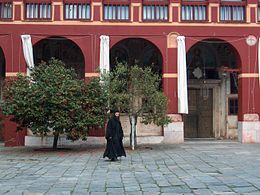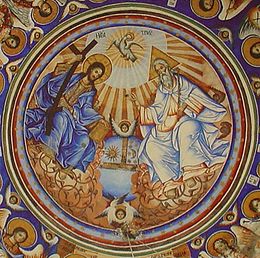Vatopedi

The Holy and Great Monastery of Vatopedi (Greek: Βατοπέδι) on the Mount Athos was built during the second half of the 10th century, by three monks, Athanasius, Nicholas, and Antonius from Adrianople, who were the pupils of Athanasius the Athonite. A legendary tradition says that its construction was ordered in the 4th century by Eastern Roman Emperor Arcadius to honour the miraculous salvation by the Virgin Mary of his son from a shipwreck. The child is said to have been found in a brier bush--hence Vato (brier) Paidi (child).

From then onwards several buildings have been constructed, most of them were built during the Byzantine period and during the 18th and 19th centuries when the monastery reached its highest peak.
About 100 monks live in the monastery today, where extensive construction projects are underway to restore the larger buildings.
The monastery is open for public view. A special permit from the monastery is required aside the one to enter Agio Oros.
Sketes attached to Vatopedi
The following large Sketes are attached to Vatopedi: the Skete of Saint Andrew in Karyes and the Skete of Saint Dmitri near the main monastery. Other smaller sketes are also attached to the monastery.
Main buildings within the walls of the monastery

- The Katholikon (primary church), dedicated to the Annunciation of the Theotokos (Virgin Mary)
- The Refectory, or trapeza
- The Byzantine period clock tower
- The 10th century NE tower which now houses the monastery's library
Treasures held within the monastery
The Monastery of Vatopedi holds a belt held by believers to be the actual belt of the Theotokos, which she wore on earth and gave to Thomas the Apostle after her death and during her transition to heaven. The silver and jewel-encrusted reliquary containing the skull of St. John Chrysostom is kept in the Monastery and is credited by Eastern Orthodox Christians with miraculous healings. The monastery also contains the Iaspis, a chalice fashioned of a single piece of the precious stone jasper, and numerous icons.
Vatopedi's library preserves a medieval royal charter, the 13th-century Vatopedi Charter of Ivan Asen II of Bulgaria dedicated to the monastery. It was discovered in the monastery's archives in 1929.
The library holds 2,000 manuscripts and 35,000 printed books. Among its manuscripts are Uncial 063 and Uncial 0102.
Land deal controversy
In September 2008, the monastery was implicated in a real estate scandal. The monastery traded low-value land for high-value state property in a deal with the New Democracy government of Prime Minister Kostas Karamanlis. The cost to the state is believed to have been at least €100 million; after the story became public, the government cancelled the land deals and two ministers resigned. Additionally, Parliament voted unanimously to set up a commission to investigate the deal.[1] [2]
Miracle-working icons within the monastery
There are four icons of the Mother of God considered to be miracle-working: Elaiovrytissa, Ktetorissa (Vimatarissa), Esphagmeni, and Paramythia.[1]

